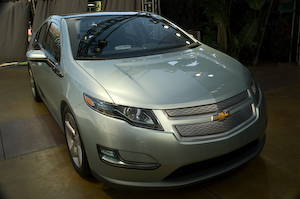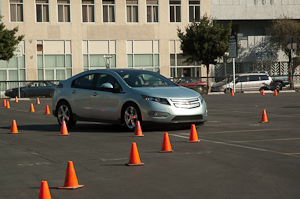![]()
 |
Chevrolet Volt - Test Drive
|
 For our test drive, we moved across the street where we were unfortunately confined to a small parking lot. So there was no chance to reach high speeds or see how well we would do merging into freeway traffic. The car we drove was one of only 80 prototypes and due to be shown at the LA Auto Show, so no doubt that was a consideration! In the end, no traffic cones were harmed during testing either.
For our test drive, we moved across the street where we were unfortunately confined to a small parking lot. So there was no chance to reach high speeds or see how well we would do merging into freeway traffic. The car we drove was one of only 80 prototypes and due to be shown at the LA Auto Show, so no doubt that was a consideration! In the end, no traffic cones were harmed during testing either.
Our first impression of the Volt was that it really drove like an electric car should. Acceleration was instantaneous and very good, with little or no sound. In production vehicles, there will also be a "sport" mode selector which will give even more acceleration.
The interior is quieter than the EV1 was, and little or no gear whine is audible. The only quieter motor is in our RAV4 EV, but in some ways, we'll miss the high-tech turbine-like whine of the motor speeding up.
An important thing to note is that while the Volt might technically be considered a hybrid because it carries a gas engine, it does not come on until the battery limit has been reached. This is the case even when putting your foot into it (yes, we were encouraged to try accelerating sharply) or driving up a steep hill. So unlike all other current hybrids, you get a true EV experience. Even though the Prius has an electric-only mode, as soon as you accelerate that car, the gasoline motor comes on.
When the Volt's gasoline engine does come on after battery depletion, it is barely noticeable. One had to actually be trying to hear and feel for it. Although we took some video while driving, our camera's poor sound recording doesn't do justice to it. But it did record Jean's surprise when told that the engine had come on, as she did not feel or hear it from the back seat where she was sitting at the time.
After recharging the Volt's batteries to be a bit above the minimum charge threshold, the engine shuts off. Thus the Volt is programmed to "prefer" being recharged by plugging in instead of burning gas (a more expensive way of recharging).
In other aspects, the Volt behaved very similarly to the EV1. Mild regenerative braking occurs when you take your foot off the accelerator. More aggressive "low gear" mode can be engaged if desired when driving down a hill. More regenerative braking occurs when you start to engage the brakes, which implement blended regenerative and conventional friction braking. This is in sharp contrast to AC Propulsion type cars like the Mini E which apply aggressive braking (enough to bring you to a complete stop on a level surface) as soon as you ease up on the accelerator.
Our preference is to have the EV1 style of regenerative braking implementation, where we are given a choice of regenerative braking strength, and especially a "coast" mode which is crucial for efficient freeway driving. In the EV1 implementation, the coast mode does not apply any engine braking (regen) when you remove your foot from the accelerator, making it very easy to maintain a steady speed on the highway. Gentle pressure on the accelerator is enough to overcome the natural deceleration of the car due to air resistance.
Like the EV1, the Volt also has a refined transition when going between acceleration to braking and back. While you might think that this would be a natural thing to expect, the RAV4 EV gives you a surprisingly rough jolt between acceleration and deceleration. The RAV4 EV also has a problem of distinct shuddering at very low speed. The Volt is smooth at all speeds. Overall, we'd give it an 'A' for the smooth speed control and responsiveness.
One "feature" both of us forgot to explicitly confirm is that the Volt creeps forward like an automatic transmission car. We disagree with most conventional drivers in that we prefer to not have this implemented in an EV (you are wasting power fighting the engine with braking to keep the car in place on a level surface), but that's probably due to the fact that we drive (and prefer to drive) manual transmission gasoline cars.
Another "feature" which will be in the production Volt (but was not in our test vehicle) is the backup pedestrian warning. This is the automatic, continuous beeping warning you often hear when big trucks are backing up. I found this to be very irritating in the EV1, so at the very least, I hope it can be turned off by the owner! It is provided for additional safety, but I think that this is of questionable safety utility. The driver should ALWAYS be responsible for paying attention when backing up, and pedestrians should ALWAYS be watching where they are going or standing in a parking lot! Except for the rare case of blind pedestrians, it takes two (idiots) to have an accident! By the way, the Prius has an even more irritating implementation -- it beeps when backing up, but only inside the car!
Some other ideas for backup warnings (if you must have them):
|